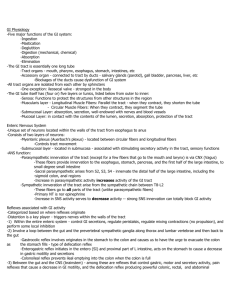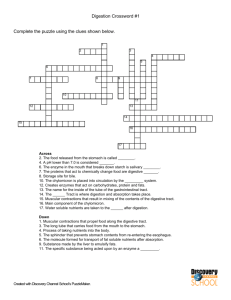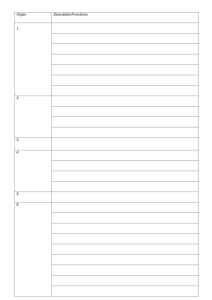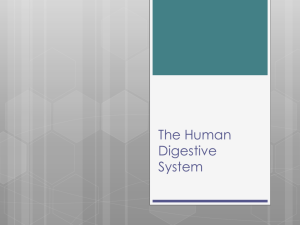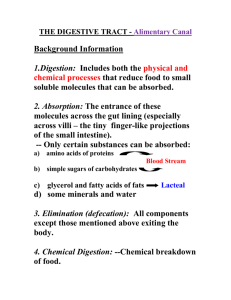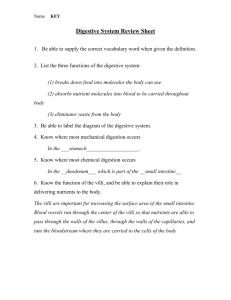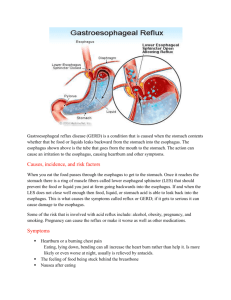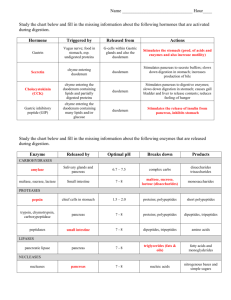PAC 01 GI Physiology(Josh)
advertisement
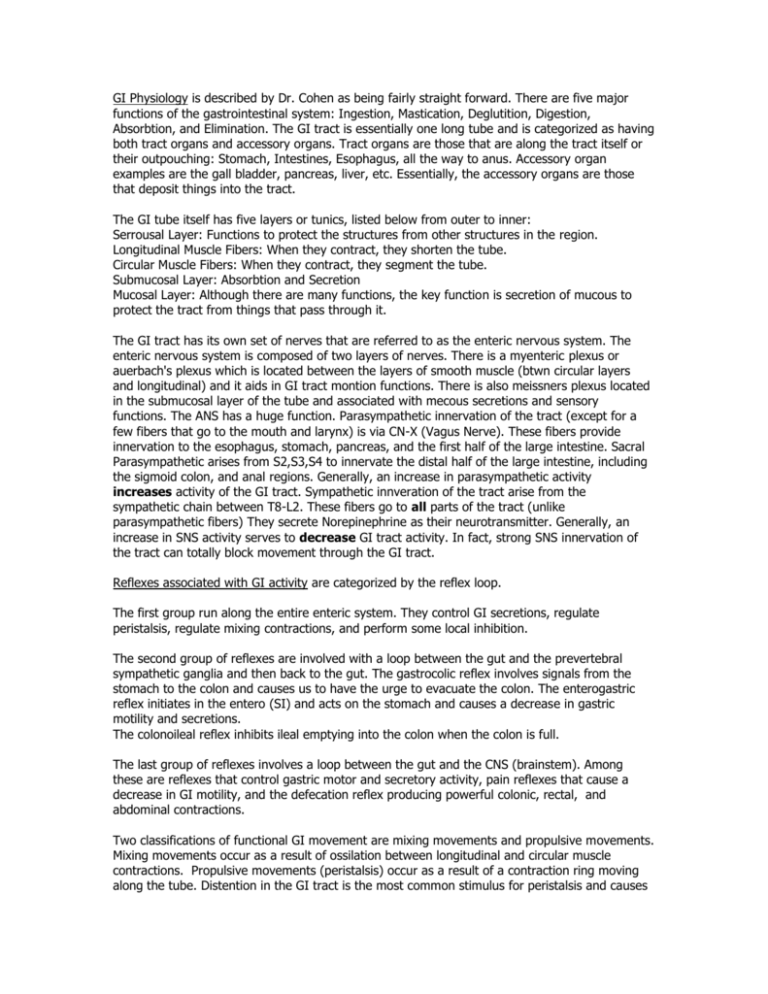
GI Physiology is described by Dr. Cohen as being fairly straight forward. There are five major functions of the gastrointestinal system: Ingestion, Mastication, Deglutition, Digestion, Absorbtion, and Elimination. The GI tract is essentially one long tube and is categorized as having both tract organs and accessory organs. Tract organs are those that are along the tract itself or their outpouching: Stomach, Intestines, Esophagus, all the way to anus. Accessory organ examples are the gall bladder, pancreas, liver, etc. Essentially, the accessory organs are those that deposit things into the tract. The GI tube itself has five layers or tunics, listed below from outer to inner: Serrousal Layer: Functions to protect the structures from other structures in the region. Longitudinal Muscle Fibers: When they contract, they shorten the tube. Circular Muscle Fibers: When they contract, they segment the tube. Submucosal Layer: Absorbtion and Secretion Mucosal Layer: Although there are many functions, the key function is secretion of mucous to protect the tract from things that pass through it. The GI tract has its own set of nerves that are referred to as the enteric nervous system. The enteric nervous system is composed of two layers of nerves. There is a myenteric plexus or auerbach's plexus which is located between the layers of smooth muscle (btwn circular layers and longitudinal) and it aids in GI tract montion functions. There is also meissners plexus located in the submucosal layer of the tube and associated with mecous secretions and sensory functions. The ANS has a huge function. Parasympathetic innervation of the tract (except for a few fibers that go to the mouth and larynx) is via CN-X (Vagus Nerve). These fibers provide innervation to the esophagus, stomach, pancreas, and the first half of the large intestine. Sacral Parasympathetic arises from S2,S3,S4 to innervate the distal half of the large intestine, including the sigmoid colon, and anal regions. Generally, an increase in parasympathetic activity increases activity of the GI tract. Sympathetic innveration of the tract arise from the sympathetic chain between T8-L2. These fibers go to all parts of the tract (unlike parasympathetic fibers) They secrete Norepinephrine as their neurotransmitter. Generally, an increase in SNS activity serves to decrease GI tract activity. In fact, strong SNS innervation of the tract can totally block movement through the GI tract. Reflexes associated with GI activity are categorized by the reflex loop. The first group run along the entire enteric system. They control GI secretions, regulate peristalsis, regulate mixing contractions, and perform some local inhibition. The second group of reflexes are involved with a loop between the gut and the prevertebral sympathetic ganglia and then back to the gut. The gastrocolic reflex involves signals from the stomach to the colon and causes us to have the urge to evacuate the colon. The enterogastric reflex initiates in the entero (SI) and acts on the stomach and causes a decrease in gastric motility and secretions. The colonoileal reflex inhibits ileal emptying into the colon when the colon is full. The last group of reflexes involves a loop between the gut and the CNS (brainstem). Among these are reflexes that control gastric motor and secretory activity, pain reflexes that cause a decrease in GI motility, and the defecation reflex producing powerful colonic, rectal, and abdominal contractions. Two classifications of functional GI movement are mixing movements and propulsive movements. Mixing movements occur as a result of ossilation between longitudinal and circular muscle contractions. Propulsive movements (peristalsis) occur as a result of a contraction ring moving along the tube. Distention in the GI tract is the most common stimulus for peristalsis and causes a ring of contraction about 2-3cm above the area of distention. Atropine is a drug that paralyzes cholinergic activity and it completely blocks peristalsis. The law of the gut is a function of the myenteric division of the enteric nervous system. It helps to ensure analward movement during peristalsis. At the same time the circular ring 2-3cm above the distention is contracting, there is focused relaxation 2-3cm below the distention. Mastication or chewing is associated with reflex activity. The presence of a bolus of food in the mouth inhibits (relaxes) the muscles of mastication. That dropping of the jaw causes stretching of the muscles and initiates the contracting reflex of the jaw. When repeated, we call this chewing. Chewing is important because it helps to break down cellulose. Deglutition (swallowing) has a voluntary stage which involves moving the bolus of food back towards the oropharynx. There is a pharyngeal stage which is involuntary. The important components of the involuntary stage are elevation of the soft palatte (covers nares), elevation of the vocal cord and hyoid bone (epiglottis covers the glottis), relaxation of the upper esophageal sphincter in the upper 3-4cm of the esophagus (allows food to enter esophagus), and distention of the walls of the esophagus (initiate peristalsis) As the bolus passes the esophagus, it next reaches the lower esophageal sphincter which is a few cm above the point where the stomach and esophagus meet. The primary function is prevent reflux of stomach contents and proteolytic enzymes from getting into the esophagus. Once that bolus is in the stomach, it is then stored, mixed with proteolytic enzymes, and ultimately pushed toward and through the pyloric sphincter. From a digestive standpoint, the stomach is divided into an upper fundus (mixing) and a lower antrim. When the fundus of the stomach is finished with the bolus, it is now a white, milky, viscous substance called chyme. Emptying of the stomach is prevented by the pyloric sphincter which is closed the majority of the time. Strong antrim contractions, along with local hormonal stimuli can inhibit the pyloric sphincter causing relaxation and emptying of the stomach contents. Distention in the stomach increases the intensity of the antrim contractions. Secretion of gastrin from the antril mucosa increase peristaltic pumping force and inhibit the pylorus. On the other side of the inhibited pyloric sphincter is the duodenum of the SI. Factors that inhibit gastric emptying include the degreee of duodenal distention, irritation of the duodenal mucosa, the degree of acidity of the duodenal chyme, the osmolality of the chyme, and the presence of certain components of fat and protein digestion. All of the above can initiate the enterogastric reflex, resulting in a decrease in gastric motility and secretions. Hormonal feedback from the duodenum that delays gastric emptying is triggerred by the presence of fat in the duodenum. These fats are released by the duodenal mucosa and then delivered by the circulatory system to the stomach and increase pyloric ton and decrease antril contractions. This allows extra time for the duodenum to digest fats. These hormonal subtances are called the enterogastrones. Included in this group are CCK (cholecystikinine) which is released in response to fatty chyme. CCK inhibits the action of gastrin. Second in this group is secretin. The last enterogastrone is GIP (gastroinhibitingpeptide). At the end of the SI (ileum), we find the ileocecal valve at the transition to the cecum. It is the only valve in the GI tract and is a very strong valve. Secretions associated with the GI tract: Generally speaking, the two major functions of secretions are breaking down of food and lubrication via mucous. The entire tract has lubricating goblet cells in varying amounts that protect the tract, especially from proteolytic enzymes. The primary stimulus for secretion is distention. Tactile stimulation can activate the enteric nervous system to release glandular secretions. Parasympathetic stimulation also stimulates secretory activity. Mucous functions to adhere food particles together and to coat the wall of the tract. It is strongly resistant to digestive enzymes and serves to mildly buffer the tract. Proximally, the first major secretion is saliva. From a digestive standpoint, saliva contains salivary amylase or ptylin. Ptylin is a starch digesting enzyme. Saliva also contains mucous, along with some bacteriocidal substances such as thiocyonate and lysozyme, and some antibodies that kill oral bacteria. Individuals that do not have sufficient salivary production are prone to cavities, ulcerations, and infections in the mouth. Saliva secretion is asssociated with CN-VII and CN-IX. After the oral cavity is the esophagus. There are NO digestive enzymes found in esophageal secretions. The only thing found in esophageal secretion is mucous to lubricate the esophagus. There is, however, digestion occuring in the esophagus as a continuation of the oral digestion of starch. As mentioned ad nauseum above, the esophagus dumps into the stomach. ALL starch digestion initiated above stops instantly when hitting the stomach from the low pH ranging from 1.8-3.5 The only digestive enzyme capable of functioning in that environment is pepsin. The other enzymes require a netural or basic environment. In addition to the mucous cells, the stomach wall contains a group of cells that fall into the category called oxyntic glands. The oxyntic glands contain mucous secreting (neck) cells, chief (peptic) cells that secrete pepsinogen, and the oxyntic (parietal cells) that secrete HCl and intrinsic factor. As a reminde, intrinsic factor is needed for Vit B12 absorbtion. In addition, the wall of the stomach contains pyloric glands that, along with secreting some mucous and pepsinogen, secrete gastrin. Pepsinogen is converted into its active form of pepsin by HCl. Regulation of gastric secretion is associated with motor impulses to the enteric nervous system and gastrin release from the pyloric glands. Gastrin is released due to stomach distention. Leaving the stomach through the pyloric sphincter, we come to the Cshaped duodenum. Review the biliary tree, including the pancreatic duct and common bile duct coming together to form the hepatopancreatic duct. Also in here is the sphincter of ODDI. Pancreatic juice contains enzymes for digesting proteins, carbons, and fats. It also contains bicarbonate ions which function to neutralize the acidic chyme entering the duodenum. The proteolytic enzymes in their active form are trypsin, chymotrypsin, and carboxypeptidase. Trypsin and chymotrypsin lyse proteins into different sized polypeptides and carboxypeptidase breaks the ensuing polypeptides into amino acids. When these proteolytic enzymes are released from the pancreas, they are inactive. Trypsin is initially released as trypsinogen, chymotrypsin as chymotrypsinogen, and carboxypeptidase as procarboxypeptidase. They are activated in the duodenum. Trypsin is activated by enterokinase from the duodenal wall. The other two proteolytic enzymes are activated by trypsin. It is vital to your health that this activation does not take place until reaching the duodenum. The pancreas also secrets a trypsin inhibiting factor that prevents conversion of trypsinogen into trypsin until reaching the duodenum. If there is insufficient inhibiting factor or a blockage in the pancreatic duct, the enzymes can digest the pancreas within hours. The pancreas also secretes pancreatic amylase which resumes carbohydrate and starch digestion, which resumes the digestion halted by the acidic stomach. Here, starchs are broken down to the diglyceride level into fatty acids and glycerol. Pancreatic juice also contains water and bicarbonate ions in varying amounts to neutralize the chyme. Hormonal regulation of pancreatic juice secretion is regulated by secretin and CCK. Secretin is mainly released in response to chyme with a low pH and causes the pancreas to release juice with a high bicarbonate ion concentration and low enzyme concentration. The acinar cells in the pancreas that S&S the enzymes are not triggered by secretin. This explains the high bicarb but low enzyme. On the other hand, CCK does have an effect on the enzyme producing acinar cells and is released due to the presence of chyme in the duodenum. CCK causes the release of both chyme and digestive enzymes. Gastrin from the stomach (increases gastric secretions and motility) has the same effect on the pancreas that CCK does. Bile is produced constantly by all hepatic cells. It is directed through a series of ducts and eventually into the gall bladder where it is stored and concentrated. In order for the gall bladder to empty, the sphincter of ODDI must relax and the gall bladder must contract. This happens when chyme with a high fat content enters the duodenum. The high fat also causes CCK release in the duodenum triggering pancreatic juice release. When the gall bladder contracts, the sphincter of ODDI is inhibited and bile enters the duodenum. Secretions of the SI is primarily mucous in response to direct stimulation or mucosal irritations. There are NO digestive enzymes secreted by the SI into the lumen. There are however, digestive enzymes found in the cells that form the wall of the SI that serve to breakdown disacharrides into monosacharrides. Sucrase digests the dissacharride sucrose into two monosacharrides; fructose and glucose. Maltase digests maltose into two glucose molecules. Lactase digests lactose into glucose and galactose. Also in the cells of the wall of the SI is some intestinal lipase that works along with pacreatic lipase to break down fat into fatty acids and glycerols. Regulation of SI secretion is tactile stimulus (causes mucous--no enzymes) and secretin and CCK (triggers pancreas). The secretions of the large intestine is primarily mucous. It functions to bind fecal matter together and to protect the wall of the LI. Absorbtion occurs as a result of increased surface area as needed. There are large invaginations in the SI called valvulae carniventes. These are also sometimes referred to as the folds of Kerckreng and serve to increase the surface area of the small intestine three fold. Located on the surface of these large folds are millions of villi. On the villi, there are even smaller microvilli. When you assess the overall absorbtive area, we find an area of about 250 square meters (about the size of tennis court) Villi have large capillary networks between arterioles and venuoles within them and also have a central lactile allowing for the transport of absorbed material to the portal system and to the liver. Pathologies of the GI system: Achalasia is failure of the lower esophageal sphincter to relax. Gastritis is inflammation of the gastric mucosa. Gastric Atrophy is associated with NO gastric gland activity. Achlorhydria is little or no HCl secretion and therefore little or no pepsinogen secretion. Esophageal Varices are varicose veins in the esophagus. (commonly found with liver dz) Ulcers (either gastric or duodenal) are lesions on the body wall sometimes caused by H. Pylori. Diverticulosis is a condition where small out pouches are formed when the mucosal lining of the SI pushes through the underlying muscle tissue. A single one is called a diverticulum. Diverticulitis is a condition of inflammed diverticula.
